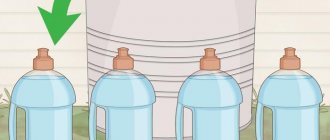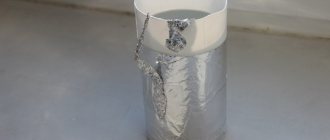My work colleague shared his joy. Finally, he acquired a country plot for a dacha. There are no buildings or trees on the territory yet, but he already has plans and worries. How to water a planted vegetable garden. They promised to drill him a well, but the new gardening is still completely without communications. That's why he's worried about how he will use the pump without electricity.
Source twimg.com
We make a pump that pumps water by itself
In order to make a water pump with your own hands, you will need the following materials:
- Two check valves.
- Plastic pipe for soldering.
- Tee.
- Knee.
- Threaded ends.
- Various containers.
- Soldering iron or torch.
- Lathe or threaded ends.
Step 1
First of all, you need to purchase two check valves with any thread.
Step 2
In order not to buy threads, you need to take a plastic pipe for soldering, which will be processed on a lathe.
Step 3
Let's start cutting threads on a lathe.
The finished threaded pipe should fit perfectly into the check valve.
We screw the second pipe to another check valve.
You can also use threaded ends to avoid having to machine the pipes. But they are quite expensive.
Step 4
This is what the finished design looks like. The water flows up. Then they go to the supply hose, where the faucet will be installed. An expansion tank will be installed in the center.
Step 5
This is what the finished structure looks like, pumping water into the tank.
How it works? This design is capable of pumping water into a tank located at a height of up to three meters. Water enters the pipe, one of the valves allows water to flow up, but not back. The second valve is the opposite and provides pulsation.
We unscrew one of the valves so that the structure starts working.
For correct operation of the valve, a continuous supply of water is required. The diameter of pipes and hoses can be any. The wider, the more water flow you will get. In this simple way, you can arrange regular watering of your garden beds if there is a pond near the site.
VIDEO: How to make a pump that works without electricity
How to make a pump that works without electricity
The pump pumps water on its own. Without using extraneous energy.
Alternative devices and methods for pumping water from the basement
If a one-time pumping of water is necessary and there is no possibility of purchasing an additional drainage pump, then you can use alternative methods.
- For example, an inexpensive submersible vibration pump of the “Springhead” type. If the depth is shallow and there is not a lot of water, then such a pump will cope with removing liquid. The main thing is to make sure that there is no debris in the water or to first remove the most dangerous foreign matter from the liquid.
When using an external drainage pump, so that it pumps out the water completely, you can resort to modifying the design of the system. When the water level in the basement decreases so much that the use of an external pump becomes difficult due to air getting into the mechanism, then use a 15-20 liter capacity. You can take a bucket. Place the hose for supplying water to the pump into a bucket and add water there with a scoop or shovel. Then all that remains is to remove the remaining puddles with a rag and dry the basement. This method can also be applied to some designs of submersible pumps, as well as when there is a large amount of debris and dirt in the water.
If there is a slope from the basement in the area, you can pump out the water by gravity. To do this, do the following:
- prepare a rigid plastic pipe, similar to an intake pipe for a surface pump;
- make an exit from the basement to the outside towards the slope;
- Immerse one end of the pipe, through the passage into the basement, into the water there;
- Place the second end of the pipe at the bottom of the area;
- if possible, suck the air out of the pipe (this can be done, for example, with a vacuum cleaner), and the water will flow out by gravity.
Methods for lifting water without an electric pump
If you are deciding how to raise water to a height, you cannot do without a pump. Only for lifting you will have to use not electric, but hand-made home-made devices, the operation of which will require the application of muscular force or the energy of the current water flow.
Archimedes screw
The invention of a screw device for supplying water to heights to fill irrigation canals was made by Archimedes around 250 BC.
Fig.1 Operating principle of the Archimedes screw pump
The device consists of a hollow cylinder, inside of which a screw rotates; during operation, it is lowered into the water intake source at an angle. As the propeller blades rotate, they capture water and the propeller lifts it up the pipe; at the top point, the pipe ends and the water is poured into a container or irrigation channel.
In ancient times, the impeller was rotated by slaves or animals, in our time there may be problems with this and you will have to additionally build a wind wheel to drive the propeller into rotation or strengthen the muscles yourself.
What in the end...
In areas where there is no electricity, you can use either battery pumps or motor pumps. But for home craftsmen there are methods that practically do not require financial investment. You can assemble a simple pump, the action of which is based on water hammer. And if the water rises from a shallow depth, then it is better to use the power of fire.
Question
Write in the comments what you think - is it worth wasting time on lighting a fire if you still have to carry water around the beds in buckets? Wouldn't it be easier to lift it from the well the old-fashioned way?
Features of unpowered water pumps
You never know where knowledge of school subjects will come in handy. Especially in physics. This device, which is built on knowledge of physics, will be discussed. This pump is solely a consequence of the development of both human progress and innovative thinking. To operate, it does not require electricity or fuel, it does not even need to do anything additional. But the pump is capable of producing good pressure and raising high columns of water, which many, without understanding it, call cheating. But this is far from true.
Making a water pump
At first glance, such a unit does not inspire confidence, because in our understanding the pumps are somewhat larger and generally different. But in fact, absolutely all the components of this unit are working, and not from any fuel, but from the ordinary laws of physics that are taught in the 8th grade. The point here is the difference in pressure created inside such a pump. The valves are configured in such a way that at a certain pressure one opens and the other closes. This is very similar to the good old accordion-type manual pump, where when pressure was applied to the operating valve, air came out, and when it was released, water flowed into the free space.
Basically, this design is made of pipes (foam vinyl chloride). It looks like a straight pipe with valves, revisions and plugs, which are mounted on a wider section of the pipe. The pipes themselves are either glued or soldered together using special equipment.
The widest part of this design is the buffer or receiver, which is necessary to equalize and accumulate pressure. There are entrance outlets on the sides. But is it worth looking at the other side? No, they are about the same. Only with the condition that the right valve is the inflow of water, and the left is the outlet.
It turns out that the water flow is supplied to the right valve. By the way, you can use ordinary ball valves instead of valves. After this, the water goes to the tee. The tee separates the flows: one flow goes up to the valve, which closes at a certain pressure, while the direct flow goes to the valve, which opens when the required pressure is reached. After this there is another tee, but this time to the receiver, and after that to the exit. It is also advisable to use a pressure gauge that will show the pressure depending on the installation location. Usually they put one pressure gauge on the inlet, but you can also put it on the return valve.
In general, we realized that water is supplied to the ball valve on the right. Next comes the tee. Tee, separates the flows. It flows up to the valve, which closes when there is sufficient pressure. And the direct flow is supplied to the valve, which opens when the desired pressure is reached.
Then, the tee goes again to the receiver and to the output. Oh, and a pressure gauge, but it may not be there, it’s not that important.
Self-made versions without power supply can be made with your own hands. If you take into account all our recommendations. In this case, you cannot do without gasoline.
What tools will you need?
Due to the pressure on the handle, the mechanical valve creates a suction effect, which, in turn, draws in liquid from the bottom of the source.
The pumping procedure is greatly simplified if there is a pump, but even in its absence it is possible to independently remove water quickly and efficiently. For this purpose, you should prepare a piston device or improvised means, such as a metal bucket, a strong rope and a special container for collecting the lifted liquid.
The option with improvised means is publicly available, but relatively complex, and a piston device for supplying water to a height can be made with your own hands. Inside the pipe with check valves, a piston moves, actively pushing water out.
Real benefits
In fact, it is not exactly a pump, but rather a pressure amplifier. This is due to the fact that it requires a certain pressure to work. This type of product is also called “hydrofor”, because both have a water seal that opens and closes the valve when a certain pressure is reached. The receiver must always be in an upright position.
According to some tests, the pump calmly draws water from streams and lakes, but not at great speed. For those who often have to go to the river for water, creating such a pump is quite a good and thorough task.
But it is better to use such a pump not on its own, but in conjunction with several such pumps: they will not interfere with each other, but the amount of water will be much greater.
Plus, you can combine them at the outlet into one water supply pipe, but the main thing to remember: the pipe must be twice as wide in diameter if there are two of these products. This is due to the fact that the basic operating principle of such a design may be disrupted and the pumps will cease to function normally.
Cleaning the pit with biological products
How to pump out a cesspool if the methods described above are not suitable for one reason or another? Modern science makes it possible to clean holes using chemicals. For example, a good solution would be biogranules, which greatly accelerate the decomposition of waste and eliminate unpleasant odors. There is an alternative way of cleaning pits: to destroy sewage, specially bred microorganisms are used, which settle in the pit and process all waste.
Pumping out cesspools can be done either independently or with the assistance of specialists or special devices. The last two options are the best solution, but the final choice must be made by the homeowner himself. In any case, the cesspool needs to be cleaned, and then it will serve for a long time and efficiently.
Sources
- https://comfortdo.ru/kak-vykachat-vodu-iz-podvala-bez-nasosa.html
- https://stroi-s-ka.ru/vodostok/kak-vykachat-vodu-iz-bochki-bez-nasosa.html
- https://sdelairukami.ru/prisposoblenie-dlya-perekachki-vody-bez-ispolzovaniya-elektronasosa/
- https://santex1.ru/kak-otkachat-vodu-iz-yamy-bez-nasosa.html
- https://iseptick.ru/kanalizaciya/vygrebnaya-i-slivnaya-yamy/kak-otkachat-slivnuyu-yamu-svoimi-rukami.html
- https://septik.guru/kanalizaciya/yama/kak-otkachat-vodu-iz-yamy-bez-nasosa.html
[collapse]
Working principle of a water pump
Even if this seems like something fantastic and like a joke, the matter lies in one secret. The second name for such a pump is “water hammer”, and they work in this way: water flows along the main line and as soon as the pressure rises, the outlet valve closes sharply, and the water moves on by inertia, then a water hammer will inevitably occur, which will create a large and excessive pressure that will capable of opening the second valve. After this, the water will enter the receiver, which will compress the air.
When the pressure drops, the outlet valve will automatically close and the water will again flow through the middle and to the top, after which the water will run to the top.
Types of pumps
Pumps come in different varieties; they mostly run on electricity, but there are also options for running on other fuels, for example, diesel. Pumps are divided into two groups: positive displacement and dynamic. Displacement pumps operate on the principle that liquid enters the working chamber and is forced out of it. They are cyclic and hermetically sealed, and also have self-priming properties. Dynamic pumps do not have a working chamber. Pumps are also distinguished by implementation: mechanical, magnetic discharge, jet and cryogenic. Pumps are also differentiated by power and purpose. But in addition to this, there are also devices for special work, such as pumps for chemical liquids and sewage pumps.
Chemical pumps are needed for pumping various liquids, mostly aggressive ones, which conventional pumps cannot handle. Often, they have appropriate coverage. The main areas of application are the oil industry and the chemical industry. It can often be found in the paint and varnish industry.
Fecal pumps are used to work in contaminated waters and liquids. They differ from others in that they are designed for a much higher viscosity than conventional ones, and also easily cope with small medium-sized particles, including sand and gravel. Sewage pumps come in both submersible and semi-submersible types.
To learn how to make a water pump without power with your own hands, see the following video.
Methods for pumping out cesspools
There are two main methods that allow you to pump out a cesspool:
- On one's own.
- Using a sewer truck.
The second option at first glance looks much simpler: just contact a specialized company, and the problem will be solved. There are a number of nuances here that must be taken into account - otherwise the risk of trouble is quite high.
- the cost of services for pumping out cesspools is quite high: calling a specialized vehicle will cost a large amount;
- any machine for pumping out cesspools has rather large dimensions, and they do not always allow one to approach the pit at a distance sufficient for pumping;
- some companies provide services for pumping out cesspools without having special permits for this: in this case, all pumped out waste can be taken to an illegal place, and all responsibility for this will fall on the owner of the pit;
- ordering a sewer truck does not always guarantee high-quality pumping, and a poorly cleaned pit will not perform its duties efficiently, so calls for sewer trucks will become more frequent.
All these shortcomings allow us to come to the conclusion that pumping out cesspools can be done with your own hands, because a good owner will definitely take care of the high-quality and competent operation of this system.
Water hammer or how to make a free pump using water energy
In this article we will talk about how to create a pump that does not require fuel or electricity to operate. The article contains a description of the operating principle of the device, the main design elements, as well as a video of the assembly process of the basic model of the ram pump. You will learn how to assemble it yourself.
Hydraulics is a science as ancient as water itself. The laws of hydraulics apply to absolutely any fluid, and we will look at how to use these laws to organize a pump or pump using kinetic energy.
The prototype of a pump based on the action of water hammer was created in France back in the 17th century by the inventor of the hot air balloon Montgolfier. Almost simultaneously with it, inventors in England, the USA and Germany patented an identical design. In Russia it received the sonorous popular name “hydroram”.
Hydraulic ram design
Conventional pumps consist of a pumping device (closed impeller, piston, membrane), an activator (internal combustion engine, electric motor, other drive), a pipeline and a valve system. The design of a hydraulic ram pump is extremely simple; its uniqueness lies in the fact that the activator and piston are the agent itself (water). Its design is notable for the fact that it has no mechanical moving parts (except for two primitive valves), and does not use fuel and lubricants and areas under constant pressure.
The base of the pump is a solid tube with three elbows, which can be assembled from ordinary fittings and pipe available at any plumbing store.
First withdrawal. A supply pipe (feeder) is connected to it; we will talk about it separately.
Second branch. A check valve, an expansion tank with soft walls and an outlet pipe are connected to it through nipples and couplings. A plastic bottle is quite suitable as an expansion tank; on factory models, full tanks are installed in a metal case with a rubber membrane.
Types of wells
Bore wells can be of two types: sand and artesian.
The first type has another name - filter well. It is drilled to the nearest aquifer in sandy soil. The depth can reach 30 meters, and the width of the casing pipe can be about 13 cm. The peculiarity of the structure of such a source is that a mesh filter is made on the walls of the pipe. To extract water from it, a deep or surface unit is required. It can last about 15 years. But the service life primarily depends on the depth of the aquifer and how intensively it is used. The second type is an artesian well. The water in it is extracted from great depths; it can reach 200 meters. It has increased productivity and high-quality water. It lasts much longer than the first type - more than 50 years. Accordingly, a more powerful apparatus must be used to lift moisture to the surface. To drill such a hole, permission is required from local government authorities.
Is it possible to get water from these wells without using an electric pump? Yes, it is quite possible, and from both types of mines. But it is important to take into account several nuances. Much depends on the hand-held devices that will be used. They usually do not provide sufficient pressure at depths greater than 30 meters. Therefore, such a system is relevant mainly for a sand well. But first, let's figure out how it is possible to lift liquid from such a structure without a pump, and what is needed for this.
How and why a hydraulic ram works
The main feature of this pump is that it uses the kinetic energy of water that is already in the flow. That is, to supply water to a height, a level difference is necessary. It can be minimal - 0.5 m, but the higher this figure, the more efficient the pump. We deliberately do not provide a hydraulic calculation - it is extremely complex and comes down only to the optimal proportion of the height difference between the water intake point, the working part of the pump and the upper drain point. Since this device will be installed in specific conditions, it is reasonable to determine all values locally.
Water entering the feeder, under the influence of gravity, tends to the lowest point, creating excess pressure to which the hydraulic valve responds. At the moment it is triggered, water is blocked in a closed system and a water hammer phenomenon occurs, which pushes water through the check valve into the expansion tank. The elastic walls of the tank accumulate excess pressure from water hammer, but not in water (it is incompressible), but in air. This pressure pushes water through the outlet channel (hose, pipe), and the check valve prevents the pressure from equalizing.
The principle of operation of a hydraulic ram pump in the video
After the pressure in the expansion tank is released, the hydraulic valve opens again and the cycle resumes. Water supply occurs in pulses. Many have already guessed that the operation of the pump is made possible due to the difference in the density of the media - incompressible water and air, which easily accumulates pressure. The entire force of the water hammer goes into compressing the gas (air) in the expansion tank, which then supplies water to the top.
Important points
When extracting water by increasing pressure inside the mine, several important factors must be taken into account. Firstly, the geological structure of the area where the well is located is taken into account.
Also important is the flow rate of the mine for extracting liquid from the ground and the productivity of the aquifer.
And, of course, the depth of the aquifer is taken into account.
If all this is not taken into account, the well may fail due to excess pressure. Simply put, liquid from the aquifer will stop flowing into the mine. This is due to the fact that the air formed inside will push almost all the water down, pressing it into the ground. Therefore, the air supply must be optimal. It should only be enough to push the water out and not create excess pressure.
Feeder and hydraulic valve
These two elements are the main ones in the design that you plan to create yourself. The entire operation of the unit depends on their size and design.
Feeder
It is a closed channel connecting the water intake point and the water hammer point. Ideally, this is a long, level pipe located on a slope. The water in the pipe is the very piston that creates excess pressure - the cause of water hammer. Therefore, the larger the cross-section, the more powerful the ram will be. The diameter of the feeder pipe should be within reasonable limits - from 50 to 150 mm. This value must be correlated with the diameter of the remaining channels of the system and the required feed height.
We recommend installing a socket in the intake part of the feeder for better water capture.
Optimal ratios of hydraulic ram pump diameters
| Feeder, mm | System, mm |
| 50 | 16 |
| 100 | 32 |
| 150 | 32–50 |
In the latter case, with a feeder length of 10 m and a drop of 1.5 m, water will be supplied to a height of 10 m at a speed of about 1500 l/hour.
Hydraulic valve
The factory model of this device may be expensive due to the material, gaskets and spring set to a certain pressure. In our case, when we use free energy, which simply does not make sense to save or take into account, the very fact of blocking the flow of water is enough. A self-made hydraulic valve is quite suitable for this.
Pump with homemade hydraulic valve - installation video with comments
The ideal place to install such a pump is river rapids with their significant drops or streams.
Factory-made hydraulic ram pumps
Of course, such simple and reliable devices could not avoid claims for mass production. Currently, they are produced by both domestic and foreign companies. However, due to their specific nature of operation (part of the water is discharged through a valve), they have a rather narrow scope of application - in urban areas they are practically useless, but are indispensable in remote, undeveloped areas, eco-villages and farms.
Today in Russia, only one company produces these environmentally friendly and efficient devices - the Ural production artel. The model range is represented by Kachalych pumps GT-01 (190 USD) and GT-03 (110 USD), as well as their varieties.
Making a pump yourself will cost a little less, even if you purchase all the parts. However, real savings are achieved if available means are available - in this case, the pump will be practically free, while its performance can be significantly higher due to a larger feeder and the throughput of the entire system.
Any device or device based on the action of natural forces deserves close attention and development. By ignoring the free energy provided by nature itself, we risk suddenly being left helpless in the absence of gasoline and electricity. Transferring household farming to alternative energy sources is the key to peace and harmony with the environment.











